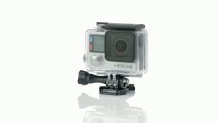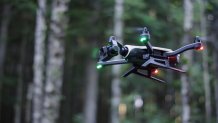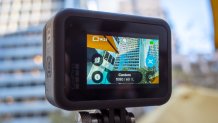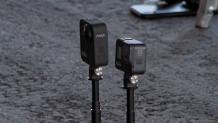What to Know
- Founded in 2002, GoPro invented the action camera as we know it today
- GoPro's tumbling stock price during the year after its 2014 IPO has become a cautionary tale in Silicon Valley
- GoPro's new Hero 8 and Max cameras are a window into CEO Nick Woodman's new direction for the company
"We grew our category from scratch," Nick Woodman told a group of reporters gathered at GoPro's headquarters in San Mateo.
It's a claim few founders can make. But before Woodman's around-the-world surf trip in 2002, there was no such thing as an action camera.
"There was no camera that was gonna allow me to film myself and my friend while we were surfing," he explained in our interview, telling a story he's now likely told thousands of times. "So I went to work on this idea to strap a camera to my wrist, and the prototype worked so well that the lightbulb went off, and I went, 'Wow!'"
A lot has happened since 2002. Woodman founded GoPro before YouTube was launched in 2005, and before the original iPhone debuted in 2007. Yet, for most of a decade, the company thrived in its niche, making affordable and nearly-indestructible cameras for high-adrenaline activities like surfing, cycling and snow sports.
But it was that early success, Woodman reflects, that led GoPro to a major bump in the road shortly after it went public in 2014.
Local
What Went Wrong
"In the early days, we didn't do any consumer research," Woodman confessed. "We invented the category, we invented the product, we had a lot of success with each product we made for so many years that we felt we could just keep growing the business that way."

But with the launch of 2014's Hero4 camera — the first to be available with a built-in color screen — GoPro began to find that its market was saturated. Among the athletes and adrenaline junkies that made up its core audience, most already had a Hero2 or Hero3 — and critics said the Hero4 just wasn't different enough to justify the upgrade.
Cheaper action cameras were beginning to creep into the market, and some customers were opting to simply shoot video with their smartphones. GoPro was left scrambling.

"We lost our way a little bit as we tried to make GoPro relevant to more people and we tried different things," Woodman said.
In an action-packed April 2016 media event at San Francisco's Pier 35, GoPro unveiled its developer program: a slew of third-party accessories that would make its cameras useful to a whole new audience — ranging from firefighters to musicians, new parents and live television broadcasters.

Then, in September 2016, GoPro unveiled its long-rumored Karma drone — an ill-fated product that was delayed, then recalled, then ultimately discontinued, after an electrical problem made some units suddenly fall out of the sky.
Back to Basics
"I think the most important lesson we've learned is to never stop focusing on super-serving your most important customers," Woodman said in our interview. "Their success with your product, their excitement for your product, their excitement for your brand, will go on to influence the next tier and the next tier and the next tier of consumers — it's influencer marketing."

In its heyday, GoPro practically wrote the book on influencer marketing. Although its stock price in September 2019 hovered just below $5 a share — a mere shadow of its $86 peak in September 2014 — GoPro remains the No. 1 consumer brand channel on YouTube, and has intermittently claimed that title on Instagram as well. It turns out that making a tough-as-nails camera, then giving it to extreme athletes to record their adventures, is a pretty great recipe for brand recognition.
"That's how we grew the business," Woodman said. "Now we're back to that formula, we're growing again, we're profitable again, and that's the approach we're sticking to."
In that sense, Woodman said, GoPro is going back to its roots: focusing on its cameras, and building them for the kind of rocket-fueled activities its army of influencers will want to record and share. But this time around, he said, the approach to building those cameras is different: it's heavily rooted in surveys, feedback and testing conducted amongst GoPro's customers.

"By doing consumer research, we learned how important things like video stabilization are to them," Woodman said.
With 2018's Hero7 — the first GoPro camera based on the new research-driven design approach — the company unveiled its HyperSmooth stabilization, billed as a digital alternative to bulky mechanical stabilizers like GoPro's own Karma Grip. The Hero7 was a runaway success, garnering a shower of positive reviews and GoPro's first quarterly profit in over a year.
Woodman said it's clear customers and investors are now expecting to see new innovation out of the company on an annual basis, and GoPro is responding with two new cameras for its 2019 lineup.
The Hero8
The $399 Hero8 is GoPro's updated flagship camera: 14 percent lighter than the Hero7, with the second version of HyperSmooth stabilization, which now works in slow motion, keeps the horizon level even when the camera is crooked, and features a "boost" button for extra smoothing when it's needed.

For the first time in a GoPro flagship camera, the Hero8 has built-in mounting "fingers," which eliminate the need for a plastic frame to hold the camera onto helmets and handlebars, and fold away when not in use. A new user interface on the camera's touch screen gets rid of the endless swiping and cycling through menus that long-time GoPro users have tolerated, replacing it with one-touch mode presets and quick toggle buttons for often-used features.

In another return to its roots, GoPro is bringing back accessory modules to its lineup. The move to a waterproof camera body with the Hero5 saw the end of the 30-pin "BacPac" connector that had been used to snap on batteries and external displays. Now, the Hero8 will be the first to work with "Mods," which clamp around the edges of the camera and add functionality. The first, called the Media Mod, includes a directional microphone and places to connect an LED light and a front-facing color display (sold separately). GoPro claims the add-ons will transform the Hero8 into a "vlogging powerhouse."
GoPro Max
The field of action cameras is becoming crowded, with giants like Sony and DJI nipping at GoPro's heels as they offer similarly-rugged cameras at competitive prices. But GoPro's second 2019 product is one the company hopes will set it apart from the pack.
"Say hi to Max," product VP Pablo Lema told the reporters gathered at GoPro headquarters, revealing the tiny black square of a camera that had been used to shoot the heart-pounding video they just watched.

Just a little bigger than Hero8, the $499 GoPro Max has a color screen and two protruding lenses, one on each side — a 360-degree camera that Lema describes as the grandchild of GoPro's two-year-old Fusion camera. Though lauded for its image quality, Fusion's slow and complicated workflow has caused it to remain a specialized product used mainly by professionals who create VR content. Max is aimed at a whole different crowd.
"It sees everything. But what you're gonna use it for is to just make videos that look like any other video you have," Lema said.
Through its consumer research, Lema said, GoPro determined that most of its users don't want to share or watch 360-degree videos, and they also don't want to spend much time editing. That should explain why Fusion cameras have been seen on clearance for 60 percent off their original $699 price. With Max, Lema said, the focus is on "reframing" those 360 videos with a few taps on your smartphone, turning them into super-smooth "flat" videos that can have an ultra-wide field of view. Because it captures everything, users can focus on skiing or surfing without worrying which way the camera is pointing, then decide later which way to "point" the video viewers will see.

"We call it GoPro Max because this is probably the maximum creative tool that we can provide to our users," Lema told reporters.
For now, Lema said, the Hero8 remains GoPro's flagship: it's familiar, dependable, and nearly impossible to destroy. GoPro Max, with the dual protruding lenses it needs to see in all directions at once, is somewhat less indestructible (although he said the company plans to provide protective lens covers for high-impact activities). But make no mistake: Woodman sees Max's spherical capture as the next chapter in the evolution of action cameras. It's also the one trick your phone still can't do.
"In many ways, a GoPro acts as a detachable lens for your phone, going places and capturing perspectives that your phone couldn't," Woodman said.



